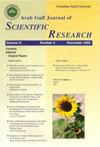Impact of consanguinity on spontaneous pregnancy loss and descendants’ health in north Morocco
Q4 Business, Management and Accounting
引用次数: 1
Abstract
PurposeThe present study aims to bring out the impact of consanguinity on spontaneous pregnancy loss (SPL) and on descendants’ health, among the population of north Morocco.Design/methodology/approachConvenience sampling was used for collecting data. A questionnaire was randomly administered to 385 couples represented by either the husband, the wife or both. The study lasted for three months, from January to March 2015.FindingsIn total, 238 valid questionnaires were analysed. The results showed that the consanguinity rate was 45.23% and that most consanguineous unions were between first cousins (91%). Data analysis revealed that SPL risk was similar in consanguineous and non-consanguineous couples (OR = 1.6; IC95% = 0.9–2.9). Also, no significant difference was observed in terms of SPL type (OR = 1.6; IC95% = 0.7–3.9) and frequency (p = 0.81). However, late SPL frequency was significantly lower in consanguineous couples (p < 0.001), whereas no significant difference was registered in terms of early SPL frequency (p = 0.73). On the other hand, consanguineous couples displayed a significantly higher risk of descendants’ health disorders in comparison with non-consanguineous ones. Moreover, the consanguineous couples had a significantly higher number of children with health disorders (p < 0.001). The risk analysis also showed that consanguineous couples displayed a significantly higher risk of congenital malformations (OR = 7.23; IC95% = 3.52–14.84) and multifactorial diseases (OR = 3.72; IC95% = 1.46–9.49), but no significant difference was observed in terms of behavioural disorders risk.Originality/valueThe population awareness regarding the negative effects of consanguinity should be raised through education programmes and premarital, prenatal and genetic counselling services.血缘关系对摩洛哥北部自然流产和后代健康的影响
目的本研究旨在揭示血缘关系对摩洛哥北部人群自然流产(SPL)及其后代健康的影响。设计/方法/方法采用方便的抽样方法收集数据。研究人员随机对385对夫妻进行了问卷调查,其中一方是丈夫,另一方是妻子,或者双方都是。研究持续了三个月,从2015年1月到3月。共分析有效问卷238份。结果表明,本组血亲率为45.23%,近亲结合最多(91%)。数据分析显示,近亲和非近亲夫妻发生SPL的风险相似(OR = 1.6;ic95% = 0.9-2.9)。两组SPL类型差异无统计学意义(OR = 1.6;IC95% = 0.7-3.9)和频率(p = 0.81)。然而,近亲夫妻晚期SPL频率显著降低(p < 0.001),而早期SPL频率无显著差异(p = 0.73)。另一方面,与非近亲夫妇相比,近亲夫妇的后代出现健康问题的风险明显更高。此外,近亲夫妇的子女有健康障碍的人数也显著增加(p < 0.001)。风险分析还显示,近亲夫妻先天性畸形的风险明显更高(OR = 7.23;IC95% = 3.52-14.84)和多因素疾病(OR = 3.72;IC95% = 1.46-9.49),但在行为障碍风险方面没有观察到显著差异。独创性/价值应通过教育方案和婚前、产前和遗传咨询服务提高人们对血缘关系消极影响的认识。
本文章由计算机程序翻译,如有差异,请以英文原文为准。
求助全文
约1分钟内获得全文
求助全文
来源期刊

Arab Gulf Journal of Scientific Research
综合性期刊-综合性期刊
CiteScore
1.00
自引率
0.00%
发文量
0
审稿时长
>12 weeks
期刊介绍:
Information not localized
 求助内容:
求助内容: 应助结果提醒方式:
应助结果提醒方式:


